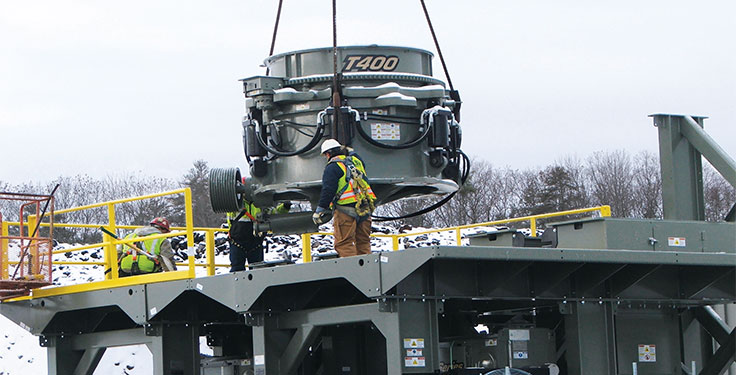
What is the hallmark of an outstanding dealer?
Perhaps it’s offering equipment brands customers know and trust, having that equipment available when it’s needed most, or regularly providing expert advice, field service or flexible pricing and terms.
To aggregate producers, all of these factors are surely important as they shop around for equipment. But one factor that undoubtedly separates a middling dealer from a top one is maintaining a vast parts inventory and having the ability to deliver critically needed parts in a timely fashion.
And by today’s standard, when producers say they need a part today they essentially mean yesterday.
“It really doesn’t matter if the equipment is free if the dealer support isn’t there to back up the machine after the purchase,” says Stewart Petrovits, an owner and vice president of Route 82 Sand & Gravel in Millbrook, New York.
Of course, backing up a machine these days means delivering critical parts in a just-in-time fashion.
“In the past, it was OK for it to take two or three days for a part to get there from the factory,” says Rick Madara, director of sales for North America at McLanahan Corp. “Now, we live in an Amazon world, and [producers] want it that afternoon if something is going to make them down for a couple of days.”
Collaboration is key
Downtime is destructive to an aggregate operation, but the supply chain’s globalization complicates parts management for a number of producers. Alan Maio, a vice president and general manager for Cemex in northern California and Nevada, explains.
“With fleets of equipment 20 years ago, a site might have had all Cat trucks and all McLanahan equipment,” Maio says. “[Now], especially on the mobile side, you’ve got two pieces of this and three pieces of that, and it makes it that much harder and costly for the producer to stock all those individual parts.”
Cemex maintains what Maio calls a “United Nations of equipment” at many of its sites because the company utilizes a variety of brands.
“It makes it difficult to keep that cost of ownership down,” he says. “You really need to have a partnership.”
This is where equipment dealers typically step in.
“A lot of the responsibility has shifted to us and then upline to the manufacturers,” says Lee Heffley, vice president and regional sales manager at Brandeis Machinery & Supply based in Louisville, Kentucky. “One of the difficulties with the [last] recession is that a lot of component manufacturers – the people who make the small parts that comprise the big machine – completely went out of business.”
Dealers and their manufacturer partners have, however, become more creative to overcome such shortfalls. Component forecasting is big for some, and utilizing a nightly trucking service is another means of ensuring parts are delivered expeditiously.
The responsibility here is not merely the dealer’s, though. Manufacturers, in many cases, realize they must bear some responsibility for parts and support dealers where they can.
“We have a guy who focuses on crushing aftermarket parts,” says John Garrison, vice president of sales at Superior Industries. “He’ll work with dealers on programs.”
As Garrison describes, some dealers are willing to stock hundreds of thousands of dollars in parts while other dealers are not. Coming to a compromise on a market’s parts needs is instrumental in any manufacturer-dealer equation, though.
“We try to put a program together based on the install base of the units in a territory,” Garrison says. “It’s identifying the critical spares and the maximum-uptime spares. And we make sure as a manufacturer that we have that backup.”
Tim Miller, sales manager at Montabert, takes a similar approach to parts management.
“We ask our dealers to stock normal wear items and tooling for breakers so when customers need something they have it ready to go on a shelf,” Miller says. “At the same time, we keep inventory of the less common parts at our warehouse with the ability to ship next business day.”
Predicting parts
Still, because dealers tend to represent a variety of brands, asking them to stock parts for 10, 15 or 20 manufacturers can be a rather large undertaking. So manufacturers and dealers cyclically come to terms on what works best.
“We make sure they have the most critical things and try to make sure it turns four times per year, for example, so something is not sitting on a shelf,” Garrison says. “If a dealer doesn’t have the space or the capability to keep a major component on the shelf, we make sure we’re prepared for that.”
In addition, a growing number of manufacturers and dealers are developing systems to predict when a part will be needed. These capabilities improve the management and delivery of parts.
“If you say it’s coming Monday then I expect it Monday – not Thursday,” says Travis Wise, vice president of operations at Wingra Stone. “And if it’s going to be Thursday then you need to call.”
What producers value most in dealers
Aggregate producers value dealers for a number of reasons, from expert advice to equipment rebuilds. Pit & Quarry surveyed producers this spring about 10 areas in particular, asking them to characterize their importance. Below, we present the percentage of producers who describe each of the following areas as “extremely important” to their operation.
97% – Parts availability/delivery
87% – Equipment availability
87% – Field service
79% – People we like and trust
77% – Equipment brands we trust
76% – Expert advice
64% – Predictive services
55% – Training and consulting
50% – Equipment rebuilds
45% – Flexible pricing and terms
Source:Pit & Quarry’s Aggregate Producer Survey on Dealers (Spring 2019)












